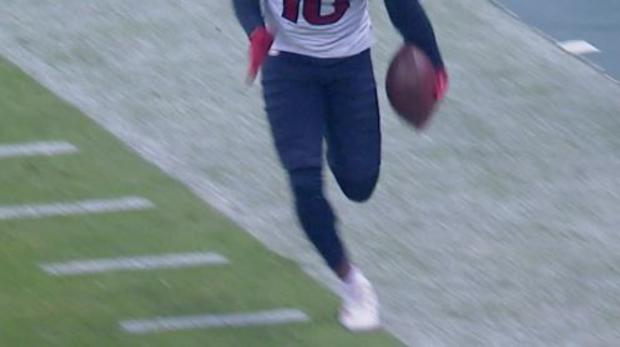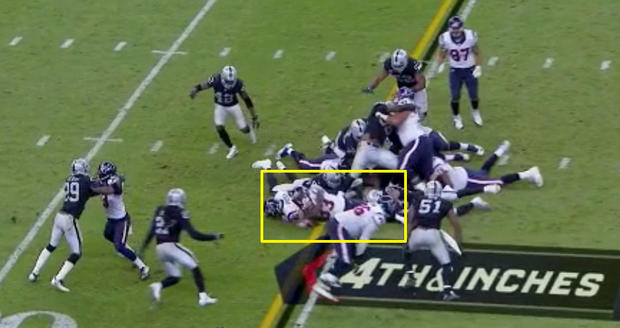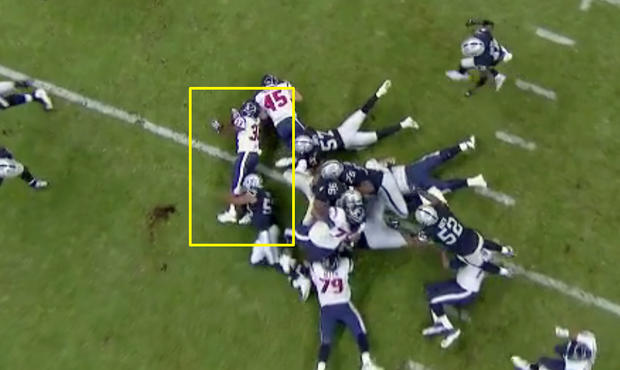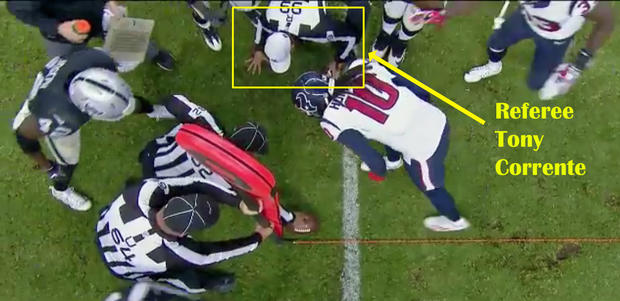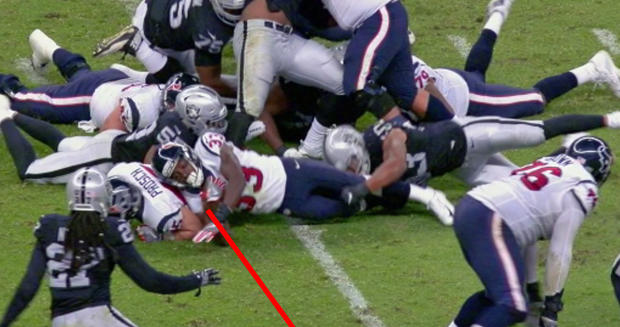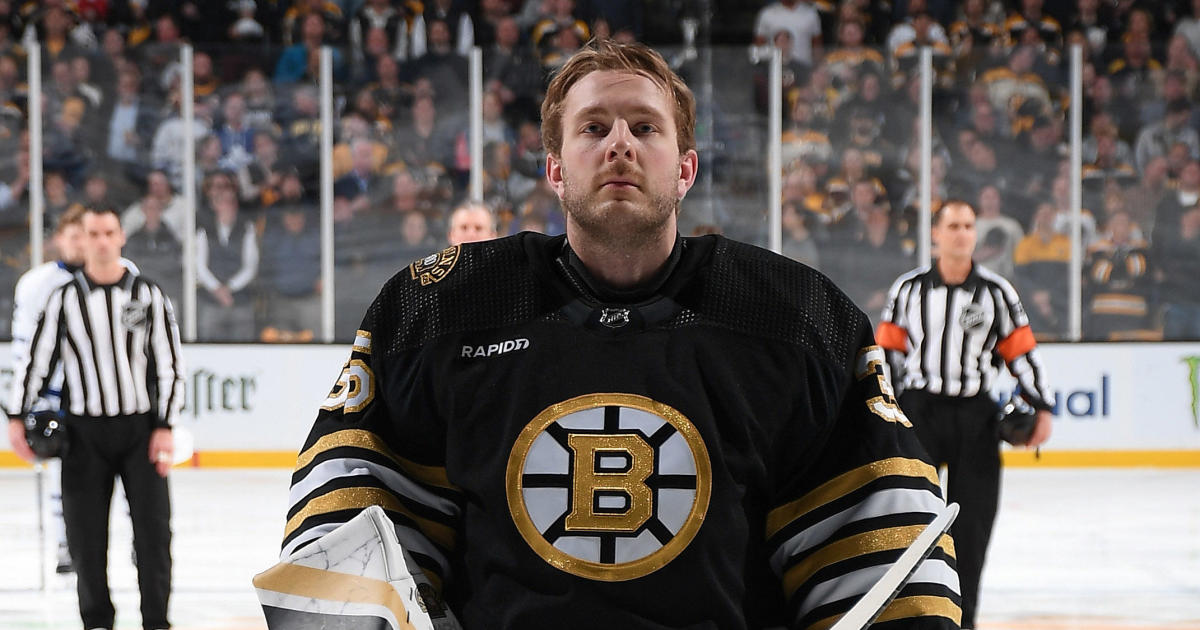NFL Officiating Comes Under Fire In Texans-Raiders Matchup In Mexico City
By Michael Hurley, CBS Boston
BOSTON (CBS) -- Poor officiating remains the NFL's greatest export.
Gripes about officiating is nothing new, of course, among the 32 fan bases in the United States. But on Monday night, bad calls went international, as Tony Corrente's crew really stepped in it a couple of times in the Texans-Raiders game in Mexico City, making a number of mistakes that really altered the outcome of the game.
It didn't take long, either. Just 150 seconds into the game, officials blew a play dead after ruling that star receiver DeAndre Hopkins -- ideally, the type of player you'd like to showcase to an audience that has never seen him before -- stepped out of bounds at the 36-yard line en route to an easy 60-yard touchdown catch-and-run.
The play was blown dead, thus killing the run at the point that Hopkins was deemed to have stepped out of bounds. There was one problem, though: Hopkins might not have been out of bounds.
Admittedly, replays were unclear. But if multiple angles at super slow-motion could not provide distinct evidence of the player stepping out of bounds, then surely an official running up the sideline with Hopkins bursting at full speed could not have seen definitively that the player stepped out of bounds.
But fear not, football fans. Head of officiating Dean Blandino popped on to Twitter to help calm the masses by dispensing some honesty, wisdom and truth. (Just kidding; he said the officials definitely got the call right, sneaking in that nugget amidst a 90-second clip of him just reciting words and rules.)
"We certainly can't say that he's obviously in bounds from this angle," Blandino narrated, admitting the particular camera angle was not definitive.
At the 56-second mark, Blandino said, "The heel looks like it's down." Then, with the angle below showing, at the 1:07 mark of the video, Blandino said, "We know the heel is down."
Granted, nothing happened in those 11 seconds to tell us that the heel was down, but Dean said we know that it's down. And so we move on.
Texans head coach Bill O'Brien said the officials told him he could not challenge the play.
"Was Hopkins out of bounds on that play?" O'Brien asked the media, before answering himself: "No."
Realistically, there's no way to tell definitively either way, and he looked more out of bounds than he looked to be in bounds, so the gripe only carries so much weight. There should be no debate, though, that if the officials on the field were correct, it was merely a stroke of luck, unless they possess vision and image-processing skills greater than those of HD cameras. The Texans ended up settling for a field goal.
And it was still a game in the fourth quarter, tied at 20 points apiece, when the Texans appeared to have picked up a first down on a third-down run by Lamar Miller. Play-by-play announcer Sean McDonough and color commentator Jon Gruden didn't even think twice about the play.
"First down," McDonough announced. "By about ... well, where are they going to spot it? It looked like he got well beyond where the official marked it. Still looks like a first down."
Gruden then fawned over Miller's field vision in picking up the first down.
Here's where Miller got tackled:
And here's where the replay showed the ball to be when his knee was down:
And here's where the officials spotted the ball:
As you can see in the second image, head linesman Patrick Turner was only able to essentially guess where the football was. There's no way he could have seen exactly where the ball was when the runner's knee hit the ground. So he guessed to the best of his ability. He was off by a foot.
That's not an attack on Turner so much as it is an exposure of the weaknesses of the system of officiating that governs the game. And because no camera was perfectly aligned with the play, O'Brien knew that a challenge to gain an extra foot would likely be fruitless.
And so, the Texans decided to go for it on fourth down. Again, they appeared to gain the necessary yardage, which this time was just about a half of an inch.
Once again, officials spotted the ball short of the first down marker. At least, that's what they said. Based on the measurement, how can anyone really tell?
Seriously, the science here is lacking a bit. It's 2016 and we've got men carrying sticks and chains, and we've got referees going into a crouch to try to see if the prolate spheroid is past a black stake. Has nobody ever watched a tennis match before? There are better ways to do this. We have the technology.
Anyways, leaving that inexact science out of it, O'Brien threw the challenge flag on this one, and he should have won. Look at where the ball is in Akeem Hunt's hands just before he touches the ground:
As you can see the ball is closer to the 14-yard line than the 15-yard line. But here is where officials not only spotted the ball but then confirmed after a replay challenge:
How that stood up after a replay remains anybody's guess.
To be clear, none of this is to particularly slam Corrente and his crew. The reality is that it's almost impossible to make these calls at full speed, surrounded by giants, with 75,000 people screaming in the stands and a head coach screaming in their ears. It's really, really difficult to be able to make precise calls down to the millimeter. But at the same time, the officials don't have the proper technology to back them up. Bad angles often lead to the call on the field standing, whether or not it's right. That entire process goes against the idea of replay reviews in the first place.
O'Brien shared some well-placed frustration after the 27-20 loss.
"I considered challenging many of the plays today," O'Brien said. "I'm not going to sit up here and get fined. I'm just a third-year coach in the NFL. But I think they really have to look at all those things. We've got all these cameras. We can't get that right?"
The goal is to get the calls right. And whether it's live on the field at full speed or after a long replay review, the goal is not met often enough to satisfy most NFL viewers.
It's a problem, and despite Blandino's insistence to the contrary, it needs to be addressed and fixed. In today's world, where every play can be replayed and shared a million times over on social media in a matter of minutes, the demand for an improved and transparent operation is stronger than ever.
You can email Michael Hurley or find him on Twitter @michaelFhurley.
